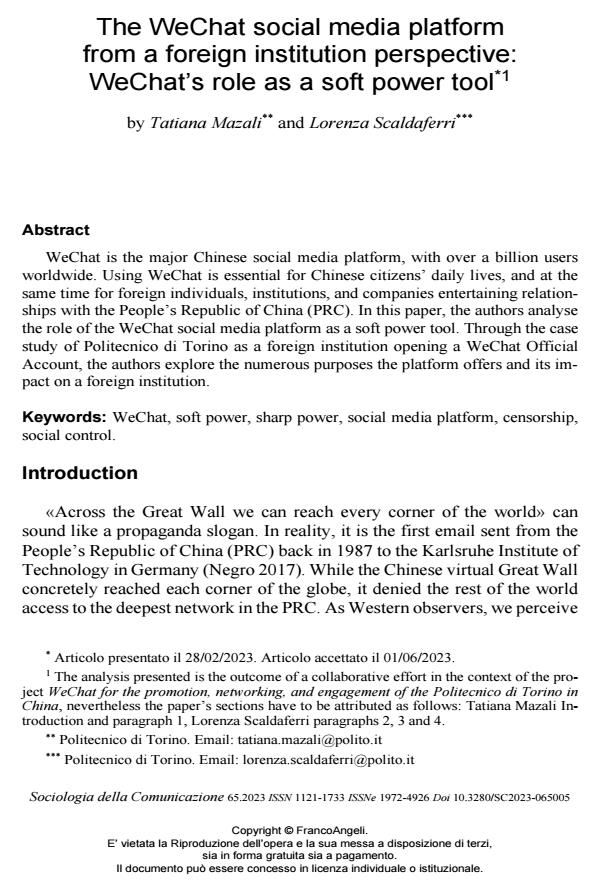The WeChat social media platform from a foreign institution perspective: WeChat’s role as a soft power tool
Titolo Rivista SOCIOLOGIA DELLA COMUNICAZIONE
Autori/Curatori Tatiana Mazali, Lorenza Scaldaferri
Anno di pubblicazione 2023 Fascicolo 2023/65
Lingua Inglese Numero pagine 21 P. 69-89 Dimensione file 459 KB
DOI 10.3280/SC2023-065005
Il DOI è il codice a barre della proprietà intellettuale: per saperne di più
clicca qui
Qui sotto puoi vedere in anteprima la prima pagina di questo articolo.
Se questo articolo ti interessa, lo puoi acquistare (e scaricare in formato pdf) seguendo le facili indicazioni per acquistare il download credit. Acquista Download Credits per scaricare questo Articolo in formato PDF

FrancoAngeli è membro della Publishers International Linking Association, Inc (PILA)associazione indipendente e non profit per facilitare (attraverso i servizi tecnologici implementati da CrossRef.org) l’accesso degli studiosi ai contenuti digitali nelle pubblicazioni professionali e scientifiche
WeChat is the major Chinese social media platform, with over a billion users worldwide. Using WeChat is essential for Chinese citizens’ daily lives, and at the same time for foreign individuals, institutions, and companies entertaining rela-tionships with the People’s Republic of China (PRC). In this paper, the authors an-alyse the role of the WeChat social media platform as a soft power tool. Through the case study of Politecnico di Torino as a foreign institution opening a WeChat Official Account, the authors explore the numerous purposes the platform offers and its impact on a foreign institution.
Parole chiave:WeChat, soft power, sharp power, social media platform, censorship, social control.
- WeChat Social Media Platform Marzia Brandolese, Lorenza Scaldaferri, in SOCIAL REVIEW. International Social Sciences Review / Revista Internacional de Ciencias Sociales /2025 pp.85
DOI: 10.62701/revsocial.v13.5450
Tatiana Mazali, Lorenza Scaldaferri, The WeChat social media platform from a foreign institution perspective: WeChat’s role as a soft power tool in "SOCIOLOGIA DELLA COMUNICAZIONE " 65/2023, pp 69-89, DOI: 10.3280/SC2023-065005